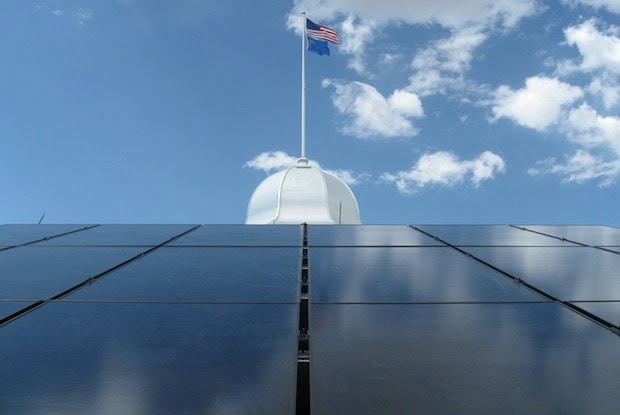
[Image above] Solar installation on the Nevada state capitol building in Carson City. Credit: Ballonboy101/Wikimedia Commons.

Reducing overall solar PV system costs, including installation, is the aim of new awards from DOE’s SunShot program. Credit: Oregon Department of Transportation/Wikimedia Commons.
The US Department of Energy last week announced awards totaling about $60 million to support innovative solar energy research and development in a variety of areas. Part of the Department’s SunShot initiative, the awards target both solar materials development to improve efficiency but also so-called “soft” costs such as solar photovoltaic system design, permitting, and installation.
According to a recent DOE report (pdf), the cost of a solar energy system has dropped by more than 70% over the past three years. Most of the price decline has come as a result of overcapacity in silicon PV cell production. However, soft costs such as installation and mounting hardware, have remained relatively steady. As a result, soft costs now account for a larger percentage of installed system costs than they did a few years ago.
Many of this round of SunShot awards are aimed squarely at companies trying to reduce soft costs. According to DOE’s press release, 17 companies will receive more than $12 million to help develop everything from online tools that can quickly map a rooftop’s solar potential to automated installation systems for large-scale PV plants.
A total of about $23 million will be awarded to university and national lab research consortia and companies to develop more efficient solar devices and stronger, more reliable components, DOE says. Approximately $16 million of those tax dollars will fund four materials-related projects to push silicon PV cells to near the theoretical limit of their efficiency of about 30%. These efforts include:
- Arizona State University, in collaboration with MIT, Caltech, the University of New South Wales, and the Swiss Federal Institute of Technology, will receive $4.5 million to “develop a novel structure for ultra-thin crystalline silicon (c-Si) solar cells based on carrier selective contacts.” The efficiency target is 29%. Arizona State will also receive more than $1.4 million to study cadmium telluride thin-film PV technology.
- Georgia Institute of Technology, with National Renewable Energy Laboratory and Fraunhofer Institute for Solar Energy Systems, will receive $3.5 million for research to push c-Si cell efficiency past 26.5%. Approaches will include using “passivated contacts via tunnel dielectrics, emitter optimization, and enhanced light trapping through the development of photonic crystals and a plasmonic backside reflector,” DOE says.
- IBM Thomas J. Watson Research Center, in collaboration with the University of Delaware Institute for Energy Conversion, the University of California, Santa Barbara, and Harvard University, will receive nearly $4.5 million to develop a model single-crystal approach to copper zinc tin selenide cell technology. The work aims at achieving targeted device efficiencies of more than 18%.
- NREL, in collaboration with First Solar, Texas State University, Colorado State University, Colorado School of Mines, and Washington State University, will receive $4.5 million to “explore the fundamental limits of doping, lifetime, mobility and surface passivation in CdTe,” DOE says. The research involves epitaxial CdTe films grown by molecular beam epitaxy, and is expected to result in devices with efficiency of 24%.
It’s not only national and university laboratories that benefit from SunShot awards. According to an article in GreenTech Media, 58 private sector companies have received backing from the SunShot program since its inception in 2007. The article says $104 million in DOE awards to these companies has been leveraged into more than $1.7 billion in private sector backing.
Author
Jim Destfani
CTT Categories
- Energy
- Market Insights
Related Posts
‘Fairy circles’ may help mark natural underground hydrogen deposits
September 18, 2025

